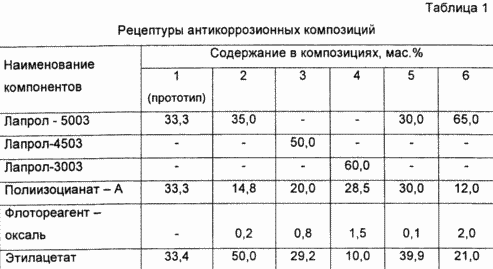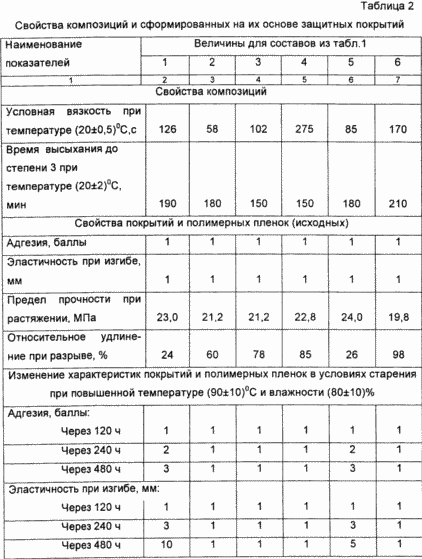| Start of section
Production, amateur Radio amateurs Aircraft model, rocket-model Useful, entertaining |
Stealth Master
Electronics Physics Technologies Inventions |
Secrets of the cosmos
Secrets of the Earth Secrets of the Ocean Tricks Map of section |
|
| Use of the site materials is allowed subject to the link (for websites - hyperlinks) | |||
Navigation: => |
Home / Patent catalog / Catalog section / Back / |
|
INVENTION
Patent of the Russian Federation RU2213113
![]()
COMPOSITION FOR COATINGS
The name of the inventor:
The name of the patent holder: Limited Liability Company "Forpost-LTD"
Address for correspondence: 105064, Moscow, Gorokhovsky per., 8-62, Patent Bureau "VOLINIK", Pat. M.S. Fedotova
Date of commencement of the patent: 2001.12.25
The invention relates to compositions of one-pack polyurethane compositions cured with air moisture and used as an independent coating or in compositions of filled paint and varnish materials intended for anticorrosion and waterproofing protection of wood, metal, concrete and reinforced concrete products. In order to obtain protective polymeric coatings having increased resistance to thermal and oxidative degradation under operating conditions at elevated temperatures in the air, the composition contains a polyoxypropylene triol with a molecular weight of 3000-5000 cu, a polyisocyanate based on 4,4'-diphenylmethane diisocyanate, ethyl acetate and a flotation agent - oxal.
DESCRIPTION OF THE INVENTION
The invention relates to formulations of one-package polyurethane compositions cured by air moisture, and can be used to obtain protective coatings for wood, concrete, and metal.
The anticorrosive coatings filled with highly disperse zinc powder are known, in compositions of which one-packing polyurethane lacquer "Laptex-2" (TU 2226-001-13013487-95) is used as a film former, cured by air moisture and manufactured on the basis of polyoxypropylene triol of "Laprol-4503" or " Laprol-4503 "and polyisocyanate (1. Patent of Russia 2,169,164 to 99127160/04 of 29.12.99, IPC 7 of 09 D 175/04; 5/10 Anticorrosive paint and varnish composition. 2. Patent of the Russian Federation 2,169,165 at application 99127188/04 of 29.12. .99, IPC 7 With 09 D 175/04; 5/10. Anticorrosive paint and varnish composition).
These compositions have a high protective effect due to the protective properties of the finely dispersed zinc powder. However, due to the high degree of filling, the advantages of the properties of the polyurethane matrix are lost, and such known compositions have insufficient elasticity in bending (2-8 mm), which in some cases limits their use.
The closest composition to the proposed one is a one-package coating composition, synthesized from a polyetherthriol polyisocyanate in an environment of anhydrous ethyl acetate (Patent RF 2073053, application 93034943/04 dated July 15, 1993, IPC 6C 09 D 175/08, Composite coatings - Prototype) . As the polyetherriol, the known composition contains a polyoxypropylene triol with a molecular weight of 3000-5000 cu, and as a polyisocyanate is a mixture of isomers of 4,4'-diphenylmethane diisocyanate, with the following initial ratio between components, parts by weight. (Wt%):
Polyoxypropylene triol - 100 (20-33.3)
This polyisocyanate is 100-200 (33.3-50)
Ethyl acetate is 100-200 (33.3-50).
A known polyurethane coating composition is process-oriented for manufacturing and when applied to protected surfaces. The polymer coatings formed on its basis have good elasticity and stability in various aggressive environments. However, such coatings are not sufficiently stable when operated in an air atmosphere at elevated temperatures (80-100 ° C), which is manifested in their embrittlement, deterioration of adhesion to the substrate and in the reduction of physical and mechanical properties.
A technical problem solved within the framework of the present invention is the creation of an air-approved polyurethane composition with a long shelf life without irreversible changes in the physico-mechanical characteristics providing for the production of protective polymer coatings having increased resistance to thermal oxidative degradation under operating conditions at elevated (80-100 ° C) temperatures in the air environment.
The solution of the above problem is achieved due to the fact that, unlike the known coating composition, the present composition further comprises a low molecular weight hydroxyl-containing reagent, which is a flotation agent-oxal, which is a product of additional processing of high-boiling by-products of dimethyldioxane production having the following physico-chemical Properties:
Ether number, mgKON / g - 0.5-4.0
Mass fraction of hydroxyl groups,% - 24-35
Density at 20 ° C, g / cm 3 - 1.00-1.12
Pour point, o С, not higher - Minus 30
At the following ratio between the components of the composition, wt.%:
Polyoxypropylene triol with a molecular weight of 3000-5000 cu. - 35.0-60.0
Polyisocyanate on the basis of 4,4'-diphenylmethane diisocyanate - 14,8-28,5
Flotoreagent - oxal - 0,2-1,5
Ethyl acetate - The rest up to 100
Polyoxypropylene triol is used as oligomers of the following brands: "Laprol-3003", "Laprol-4503" and "Laprol-5003" (TU 6-05-1513-76; TU 6-05-2033-87; TU 6-05-62- 93).
Polyisocyanate on the basis of 4,4'-diphenylmethane diisocyanate has the trade mark "Polyisocyanate-A" according to TU 113-03-38-106-90.
The properties of the ethyl acetate used must comply with GOST 22300-76.
Flotoreagent - oxal in its characteristics must meet the requirements of TU 2452-029-05766801-94 (T-92 and T-94).
The proposed limits of the relationships between the components of the compositions are determined experimentally and are optimal, from the point of view of the achieved positive effect. The use of ethyl acetate in an amount of more than 50% in the formulations is impractical due to the fact that such compositions with a low dry residue do not provide sufficient thickness of the resulting protective coatings. If the content of ethyl acetate is less than 10% in the mixture of the initial components, the resulting composition is a highly viscous liquid, the packaging of which and further use in consumers is difficult due to its non-technological nature.
The recommended proportions between reagents - polyisocyanate and polyoxypropylene triol - provide an optimal complex of physico-mechanical and protective properties of the polymer coatings formed. With a higher polyisocyanate content, the protective coatings formed are sufficiently rigid and do not have the necessary level of elasticity. A smaller amount of polyisocyanate slows down the rate (affirmations of the composition after its application to the protected surfaces.
The proposed concentration range of the flotation agent is oxal, due to its effectiveness in ensuring the stability of protective coatings to thermal oxidative degradation. The content of this reagent is more than 1.5% does not lead to a further increase in stability, and less than 0.2% - is ineffective.
Comparison of the proposed composition with the known composition - a prototype allows us to conclude that it corresponds to the criterion of "novelty", since in this case contains a new set of ingredients in a new quantitative ratio.
The "inventive level" of the proposed technical solution is illustrated by the foregoing and consists in the fact that the additional introduction of the flotation agent - oxal - into the composition of the flotation agent resulted in a non-obvious effect - an increase in the stability of the physical and mechanical properties of polymeric protective coatings operating in the regime of thermal oxidative aging. This effect could not be predicted in advance, since there is no scientific and technical information on the thermostabilizing properties of the flotation agent-oxal with respect to polyurethane materials. It is known that the main areas of use of the flotation agent are the oxal of T-92 and T-94 grades - the production of plasticizers for rubber products and film materials, the regulation of structural-mechanical and filtration properties of water-based drilling fluids while drilling oil wells, flotation of non-ferrous metal ores And some mineral raw materials.
The proposed composition, like the prototype composition, can be made from commercially available materials on known chemical equipment, which allows us to conclude that the proposed technical solution meets the criterion of "industrial applicability".
Samples for the testing of polymer films and coatings were prepared by conventional methods. The thickness of coatings in all cases was 60-80 μm. Drying time to grade 3 was determined according to GOST 19007, the conventional viscosity of the compositions was determined on a viscometer B3-246 with a nozzle diameter of 4 mm in accordance with GOST 8420, the adhesion of coatings to a metal substrate was evaluated in accordance with GOST 15140 (method 2), elasticity of coatings in bending was determined in accordance with GOST 6806 , The physicochemical characteristics of polymer films under tension were determined in accordance with GOST 263.
The resistance of the coatings to the thermal oxidative action (air atmosphere at a temperature of 90 ± 10 ° C) was evaluated in accordance with GOST 9.403 (method A) on the change in the adhesion of coatings, their elasticity and the change in the physical and mechanical properties of polymer films.
The technical essence and advantages of the present composition are illustrated by the following examples.
Example 1 (by prototype)
The reactor with a stirrer and a reflux condenser was charged with Laprol-5003, ethyl acetate, and a polyisocyanate was added with stirring. After that, the contents of the reactor were heated to the boiling point of the solvent at 75-80 ° C and kept in this regime until the content of the MCO group in the final composition was 10-12% constant. The composition of the composition is given in Table. 1, and its characteristics and properties of the formed coating in Table. 2.
Examples 2-6
The composition according to the invention was prepared analogously to the prototype composition.
Flotation agent-oxal was introduced into the reactor together with polyoxypropylene triol. The formulations of the compositions are listed in Table. 1, and the characteristics and properties of the resulting protective coatings in Table. 2.
 |
|
 |
Thus, as can be seen from the comparative examples, the claimed polyurethane composition at comparable levels of viscosity and drying time provides greater stability of the protective coatings formed on its basis to thermooxidative degradation: the change in adhesion strength and physicomechanical parameters over time is much slower than in coatings, Obtained from the prototype composition.
CLAIM
A coating composition comprising a polyoxypropylene triol having a molecular weight of 3000-5000 y. E., Polyisocyanate based on 4,4'-diphenylmethane diisocyanate and ethyl acetate, characterized in that it further comprises an oxal flotation agent, which is a product of further processing of high-boiling by-products of dimethyldioxane production, with the following ratio of components, %:
Polyoxypropylene triol with a molecular weight of 3000-5000 y. E. - 35.0 - 60.0
Polyisocyanate based on 4,4'-diphenylmethane diisocyanate - 14.8 - 28.5
Flotoreagent - oxal - 0,2 - 1,5
Ethyl acetate - The rest up to 100
print version
Date of publication 01/18/2007





Comments
When commenting on, remember that the content and tone of your message can hurt the feelings of real people, show respect and tolerance to your interlocutors even if you do not share their opinion, your behavior in the conditions of freedom of expression and anonymity provided by the Internet, changes Not only virtual, but also the real world. All comments are hidden from the index, spam is controlled.